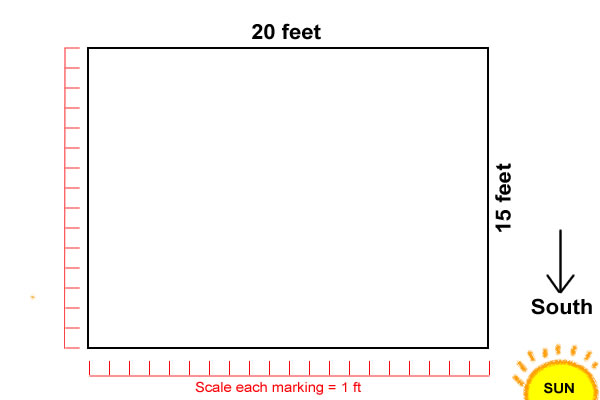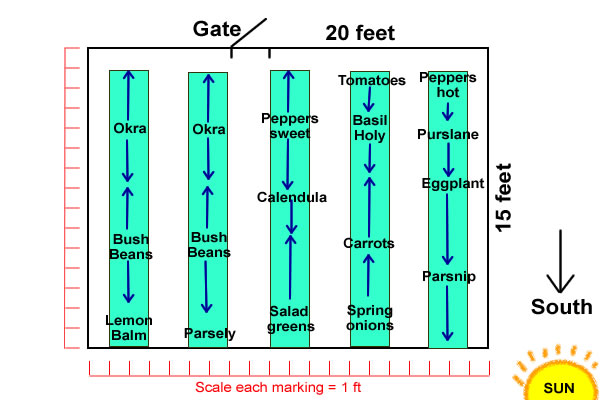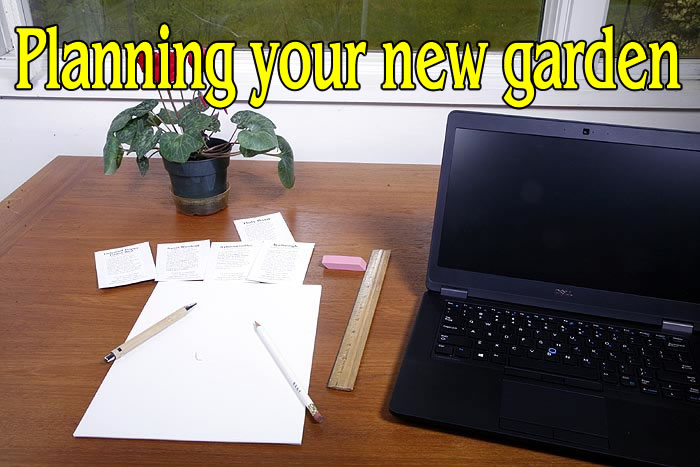PLANNING YOUR GARDEN.
It's always a good idea to plan out your garden before you plant it. Every vegetable farmer, market gardener and seasoned gardener will do this. It's pretty simple but can make all the difference in how well your garden grows.
In this discussion we will focus on planning a garden to grow vegetables, herbs and medicinal herbs. For the most part this is what most people will want to focus on during these troubling times. Growing a selection of vegetables and herbs will offer the best use of land and provide good resources for you and your family. This article also assumes that you want a fairly fast return, something you can grow and harvest in one year. For this reason no sweet fruits are included as these tend to be perennials and wont give fruit in the first year. Exception is Cape Gooseberry (Goldenberry) but this takes a lot of room even when trellised.
HOW TO PLAN YOUR GARDEN.
1. Walk around your property and see where you have space to put your new garden that has plenty of sunlight. Don't place it under trees or in a shady spot. Do this on a sunny day so you can see the light and watch for shadows. In early spring there are no leaves on the trees so its easy to mistake where there may be sunshine. Look at where the shadow of the tree is. If your intended garden falls in this shadow then it will be shaded when the leaves come out. Find another location.
2. Once you have the spot determine how large your new garden is going to be. Use sticks of some kind to mark our the area. For most gardens a square or rectangle is the best shape simply because its easy to maintain but any shape is fine as long as you are happy with it.
3. Measure the size of your garden. It's good to do this with a tape measure if possible if not pace it out. Measure your pace and then do some math to determine what the size is.
4. If you have never created a garden before don't make it too large. It may seem a great idea now but when you come to create and maintain it you may think differently. You can always make it bigger as you go along.
5. Now to the planning. Take a piece of paper and draw the outline of your garden on it. If possible do this to scale, its going to be easier to transfer your plan to the ground if you have some sense of the scale. Otherwise when you get out there your plan may not work.

Initial garden outline. Size of the plot and a scale plus direction
of the sun.
6. Think about the Sun. Which direction is it coming from? The
best way to create a garden is to have the rows face parallel to the sun
so that all the plants get the same amount of light. Sun will shine on
the whole row evenly. If you put them perpendicular to the sun then only
one side of the row will get sunshine the far side will not.
Additionally with this method if plants grow tall they will shade the
rows behind them stunting the plants.
7. Once you have determined the direction of the light, the width of the rows and aisles you can determine how many rows you can achieve in your new garden.
8. Draw in where the rows of plants are going to be. Remember there will need to be rows of crops and then aisles between them that you can walk on to tend and harvest them. Plants need to be some distance from each other in order to grow and fill out.
- Rows should be at least 1 foot wide 2 feet is a better calculation
as many plants get very large.
- Aisles where you are going to walk should also be at least 18"-
2 feet. You many thing you can walk down a one foot wide aisle now but
when the garden is full of plants it will be a different matter.
- If you intend to put a fence around the garden to stop wildlife then make sure you allow space on the edges of the garden. Don't put a row right up against the fence as you will not be able to access it and wildlife can attack it through the fencing. Leave at least a foot between the fence and the first row.
9. Draw these on your plan in pen or other permanent marker. Now you have a blueprint for your garden. Keep this. If possible photocopy it, scan it into your computer so you can print it out for later use. Unless you change the size of your garden you can use this plan in years to come.

Positioning rows in the garden. These rows are two feet wide with two foot
aisled in between. We have assumed that the garden will have a fence around
it so there are aisles on the outside of the rows between the crop and the fence
so you can get around the whole garden. There is also a gate at the back and
small row for you to move around the garden without stepping over plants. Its
on the north end to maximize sunlight to the garden. If you don't plan on using
a fence this feature can be ignored..
10. Make a list (if you have not done so already) of all the plants you want to grow in your garden.
11. Now use a pencil to start writing in which plants you are going to place where. A pencil is necessary as you may not get them in the right place to begin with. The most common mistake is trying to fit far more plants into the garden than there is room for. Secondly is getting the spacing of the plants right allowing enough room for each to grow at its best. Its important to ensure you have enough room but not too much for each plant. Changes get made all the time. We plan all our fields in pencil and use an eraser often until we are finally done.
FACTORS TO CONSIDER when placing plants.
1. How tall will your plants grow
2. How wide will the plants grow
3. Are the going to need supports? If so they will need more room.
4. How long does it take the plant to grow and mature. In some cases plants are very quick so you can reuse the space for a second crop.
Even in a garden facing south with parallel rows it's a good idea to
put tall plants at the back of the garden so they wont overshadow the
rest.
If your plants need a frame or support make sure that this wont overshadow
other plants. Putting it on the west side of the garden ensures that the
rest of the garden gets as much light as possible during the day without
overshadowing from the frame.
Make sure you know how large your plants will get. Planting tomatoes
in the center of the garden with a one foot path each side of a two foot
bed is going to cause problems. Tomatoes can get large and spread out.
They will need supports to keep them up they will overshadow other plants
easily. If growing cherry tomatoes be aware these can grow to 7 feet in
height and need a lot of support so place on the west side where they
wont overshadow anything else.
For herbs if growing a tall herb like Sweet
Annie (Artemisia annua) these can get BIG over 8 feet in height and 4 feet
wide. They take a lot of room and will overshadow other plants.
If growing anything in the squash family put them at least 12 feet from any other plants they will grow large and take over everything. We even had one grow up the side of our house and onto the roof!
If planting anything that is permanent such as any berry bushes or strawberries think carefully about where to put them so they wont overshadow any other plants. Also plan to have a net covering for berries of the birds will eat everything.
Think about how much of each plant you need. For most homes two of three
tomato plants are sufficient to have fruits all summer long. Peppers you
will need more.
Bush and pole beans will need more. Be aware that many bush beans fruit
all at the same time so you will need to harvest and store your crop.
If you want a continual harvest you may need to pick pole beans which
tend to fruit on a continual basis but they will need a frame to grow
up.
Plant short plants like lettuce and many herbs at the front of the bed. Lettuce grows fast and needs to be continually re-sown so make sure you leave enough space to grow several batches. If using the same soil make sure you add compost or other organic material and feed on each resowing or the plants re-sown will not do well as the first plants will have taken all the nutrients.

Plants positioned in the new garden. The choices are yours and will
depend on what vegetables you like to eat and what will grow in your area.
Grow more of things you really like and less of things you only eat occasionally.
If you get it wrong and some things overrun others or plants die, don't worry about it. Learn and try again with something else. In many parts of the country there is sufficient warm weather to sow quite late into the year and still get a crop even if the first one fails.
12. Once your plan is complete you can begin thinking about how
to construct your garden, or if you need to make it bigger to accommodate
all the plants you want to put in it. Now you are ready to go out and
prepare your garden. Its never too early to start this task. It could
take several sessions as you get used to the new activities.
OTHER NEW GARDEN INFORMATION
How to start seeds to get the best possible plants.
Tools You Need To Make A Simple Garden.
How to Choose a Potting or Seeding Mix.
What Plants should I grow in my new Garden?.
Designing your garden for summer heat
Potting on your seedlings get get the best possible plants.
| Janice Hazeldine PhD is the owner and head grower of Floral Encounters an organic Medicinal Herb farm that is also a designated sanctuary for pollinators. |






